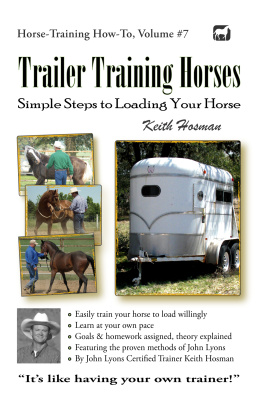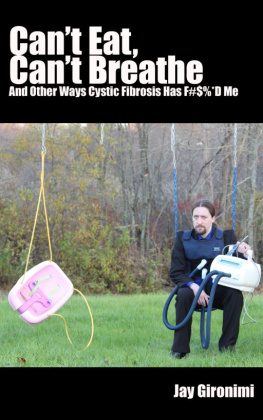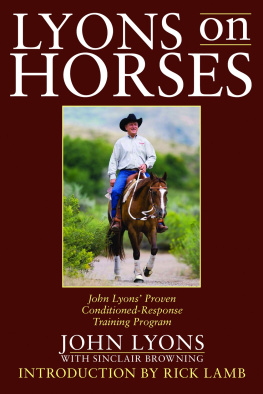Addendum
After the initialrelease of this book, I received some interesting questions. Iveincluded the resulting Q&A here, figuring that others might findthemselves in similar situations.
Michelle F asks: Ihave a question about the "mechanics" of loading a horse.We have a 2-horse straight load trailer with a ramp. There is adivider down the middle as a barrier between two horses. And there isa door to a dressing room in front of the divider. In the past, oneperson has walked the horse into the trailer. A second person securesthe butt bar and closes the ramp. In your book you say "Don'twalk onto the trailer to load your horse. He should walk 'past you'to load himself." I'm having a hard time picturing this. And, doI keep the lead rope attached to his halter?
My Answer: If yourhorse is accustomed to trailering and you feel he can be trusted; youcan walk the horse into the trailer if you'd prefer. With a nervoushorse - or one that is new to being in a trailer, I strongly advisethat you stand outside and allow the horse to walk onto the traileralone. Lead the horse to the back of the trailer and then cue it toload using the "Go Forward" cue. The horse will then walkpast you, into the trailer, in the same way that someone might walkpast you if you've held a door open for them. And, regarding the leadrope... Yes, swing it over his back or loop it safely around hisneck. You'll leave it attached in case he unloads without your askinghim to do so. Quite often, a nervous horse will back out very quicklyand unexpectedly - and if you leave the lead line swung over thehorse's shoulder, you can easily grab it as he rushes out of thetrailer.
Tommie H asks: Whatdo I do with the lead rope once the horse is inside?
My Answer: I don'tknow how your trailer is constructed - but on most you can eitherreach in through a window, near the front, to remove the lead lineand tie the horse (if they've been taught to tie) - or you can justwalk into the trailer yourself, in order to remove the lead and tiethem. It's not "Don't ever go in the trailer" it's "Don'tgo in a trailer with a nervous horse or one that's being forced inthere."
Nancy M asks: Myhorse seems to be getting an attitude. After some practice(approaching the trailer and putting his front feet inside) he justgets sloppy in his movements and seems to completely quit trying.Ive never done this before and Im afraid it might beunsafe to keep pushing. How do I wake him up?
My Answer: When yourhorse seems to run out of gas, motivate it by asking it to lungequickly around you in figure-eight patterns. Remember - in horsetraining - it's always "energy in, energy out." Charge itback up with some rapid exercise, then go back to your loadinglesson.
If your horse seemsto simply quit trying - and especially when it cops a bad attitude -ask it to back away from you. (Back farther each time you have to dothis to instill more motivation - stay calm and business-like.) Then,when you bring the horse back to the trailer, practice moving theshoulder away from you (necessarily creating a bow in the horsesbody, arching the shoulder away from you). As you do, insist that thehead be kept level and the neck relaxed - just as you learnedpreviously in this book. Make this (arching away) a habit; youllneed this ability when the horse starts to throw the shoulder at you,dodging to the left to avoid entering the trailer. (Theyll alltry this at some point.) If necessary, move some distance away andpractice this until you get it pat, then advance to the trailer,asking it to bow the shoulder every few steps...step, step, bow;step, step, bow. The more intimidating your horse, the more importantthis is.
Fernando P asks: Arethere any tricks to speeding this up, to making the horse get in thetrailer any faster? Im following the book closely, but I getthe feeling this might take all day with my super-stubborn horse.
My Answer: Heressomething to try - it'll make this easier for your horse - and shiftyour training into a higher gear. If your trailer doesnt havea walk-up ramp, build a simple step out of lumber scraps. Create anunderlying frame the length of your horse and the width of theentrance to your trailer - then cover it with three-quarter inchplywood. (A horse might step through thinner plywood.) The addedheight will make it easier for the horse to take that first step.Also, it'll make it easier for your horse to find its footing whenbacking off and taking that very first step down to the ground - theground is often quite some distance below them and they seem to feelas if they might fall. I know that, in my experience, this simplechange has made things move much more quickly.
Move away from thetrailer to begin your practice, using your Go Forward cue to teachthe horse to move up fully onto the step and pause there - pausebriefly before asking the horse to either finish crossing the step -or to back back off. Alternating between the two choices - forwardand reverse - will strengthen the control you have because it willprevent the horse from automatically assuming that you want it toload (or, unload, for that matter) and then blowing past you likesome runaway locomotive. Train against a wall if the horse wants tostep off to one side or the other. When itll easily walk uponto the step and stand there relaxed - and just as easily step backoff - move to the trailer.
End
Preface
If you're leaving at 7am, don't wait till6am to find out whether your horse loads!
Is there anythingmore aggravating than having to coax a stubborn one thousand poundanimal into a box on wheels when you're running late?
The book you'reholding, "Trailer Training Horses: Simple Steps to Loading YourHorse" will get your horse trailer-trained for good. You'll findit broken down into five "Days" or segments:
- Day 1: Easytrailer loading begins with solidifying good ground manners.
- Day 2: Setyourself up for success; work to gain fine control over your horse'sindividual body parts
- Day 3: Twodifferent ways to get your horse into the trailer
- Day 4: Exercisesfor hard-luck cases; training tips for everybody
- Day 5: Do's,Don'ts and What-To-Do-Ifs. Plus, notes on tying. Horses that won'tunload. Horses who "thrash" and more...
And, finally... I'veincluded a chapter explaining how to use a roundpen to teach yourhorse to actually look for open trailers. With diligence, you canactually train your horse to load into trailers some distance away...when you simply point!
I call theindividual segments "days" but you should take this work atyour own speed. Some days will be easier than others. And, while youcan breeze through everything in hours, you might want to split it upover days or weeks. It's completely up to you.
Good luck in yourtraining!
Keith Hosman, JohnLyons Certified Trainer
Day One
Prep work: Teach the"Go Forward" Cue
On a good day,Mary's horse will get in the trailer after a few minutes of cajoling.More often than not, it's about fifteen. Today she's headed to ariding club event and the group leaves for their trail ride at 10amsharp. She's running a bit late, but as she leads her horse to thetrailer, she figures that she'll make it fine if the horse is havinga "good-to-medium day." If he loads by 9:15; she can drivethe speed limit and stop for coffee. If not, she's gotta do 80, nevermind Starbucks. She's happy with her horse at this point and verymuch looking forward to the day. Unfortunately, her horse has gottenup on the wrong side of the manger and he's thinking "I'll diebefore I climb in that trailer."
Forty minutes latershe's thinking thoughts like "It's just a stupid trailer,""I'll drag your butt in" and "Your dang mother was thesame way."
Horses either get insmoothly or they balk. If your horse balks, he doesn't load. Period.Trained horses simply walk into the trailer. Not after 10 minutes ofbegging; they just walk in. That's lesson number one and our ultimategoal. If your horse has become a hard-luck case then it's going totake time... consistency... and work from you... to get thisstraight. But you will. The good news is, horses are actually easierto teach to trailer than you'd think. The bad news is, it takes thepatience of an oyster. Not so much time, as patience. Horses that"should trailer but don't" have had some steps skipped intheir trailer training. No big deal. We'll cover A to Z here; you'lltake it one step at a time and we'll get that dang horse in thetrailer together!










